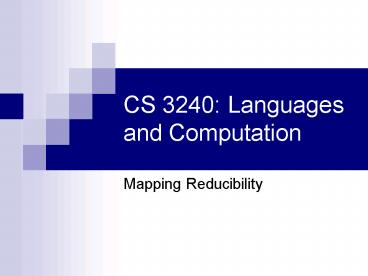CS 3240: Languages and Computation - PowerPoint PPT Presentation
1 / 15
Title:
CS 3240: Languages and Computation
Description:
Define collection of dominos so that a match corresponds to an accepting computational history. Internally, define sets of dominos for each transition function ... – PowerPoint PPT presentation
Number of Views:78
Avg rating:3.0/5.0
Title: CS 3240: Languages and Computation
1
CS 3240 Languages and Computation
- Mapping Reducibility
2
A Simple Undecidable Problem
- Is there an example of undecidable problem that
is not related to automata? - Post correspondence problem (PCP) is such an
example - A domino looks like , where u and v are
two strings - Given a collection of dominos, can you make a
list of dominos (repetition allowed) so that the
concatenated string on the top is the same as
that on the bottom? - Example
3
PCP is Undecidable
- Proof idea
- Reduction from ATM via computation histories
- Define collection of dominos so that a match
corresponds to an accepting computational history - Internally, define sets of dominos for each
transition function - Many technical details for treatments of
boundaries, which depend on input string to ATM
4
TMs and Computation
- TMs can do more than just accept and reject
strings - They can perform functions
- Definition A function f? ? ? is a computable
function if there is some TM M that, on every
input w, halts with f(w) on the tape
5
Examples
- The copying TM
- Start with w on the tape, halt with ww on the
tape - Summation
- Takes input and returns value of mn
- Finding intersection of two DFAs
- Start with on the tape, where A and B are
DFAs, halt with on the tape, where L(C)
L(A) ? L(B)
6
Mapping Reducibility
- Definition Language A is mapping reducible to
language B, written A?mB, if there is a
computable function f? ? ?, where for every w, - w ? A iff f(w) ? B
- The function f is called the reduction of A to B.
B
A
7
Mapping Reductions Decidability
- Theorem If A ?m B and B is decidable, then A is
decidable. - Proof Let M be a decider for B and let f be a
reduction from A to B. - Consider the following TM, N
- N On input w
- Compute f(w)
- Run M on f(w) and report Ms output
- Then N decides A
8
Mapping Reductions Undecidability
- Corollary If A ?m B and A is undecidable, then
B is undecidable. - We have been using this corollary implicitly
already
9
Example
- We showed that HALTTM is undecidable by
contradiction - Now lets show its undecidable using mapping
reduction - Need a function that takes input
- Halts if M accepts w, and loops if not
10
Mapping from ATM to HALTTM
- F On input x
- If x ? for some TM M, output x
- Otherwise, construct the following TM
- M On input x
- 1. Run M on x
- 2. If M accepts, accept
- 3. If M rejects, enter a loop
- 2. Output
- If M accepts w M halts on w, otherwise M loops
or generates a string not in HALTTM - I.e., ?ATM iff ?HALTTM
11
HALTTM is Undecidable
- We just showed that ATM m HALTTM
- Since we know ATM is undecidable, we can conclude
that HALTTM is undecidable
12
Reductions TM-recognizability
- Theorem If A ?m B and B is Turing-recognizable,
then A is Turing-recognizable. - Proof (same as decidable proof) Let M be a
recognizer for B and let f be a reduction from A
to B. - Consider the following TM, N
- N On input w
- Compute f(w)
- Run M on f(w) and report Ms output
- Then N recognizes A
13
Appls. of Mapping Reductions
- If A ?m B and B is decidable, then A is decidable
- If A ?m B and A is undecidable, then B is
undecidable - If A ?m B and B is Turing-recognizable, then A is
Turing-recognizable - Equivalently, A ?m B
- If A ?m B and A is not Turing-recognizable, then
B is not Turing-recognizable
14
Reductions non-TM-recognizability
- Corollary If A ?m B and A is not
Turing-recognizable, then B is not
Turing-recognizable. - Question Which language that have we seen is
not Turing-recognizable? - Answer ATM
15
EQTM
- Theorem EQTM is neither Turing-recognizable nor
co-Turing-recognizable. - Proof
- Reduce ATM to EQTM.
- Given input
- Construct M1 that accepts nothing
- Construct M2 that accepts nothing if M accepts w
- Reduce ATM to EQTM.































